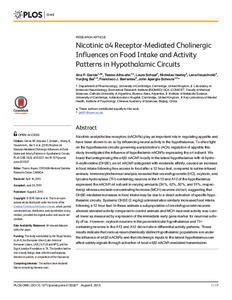Por favor, use este identificador para citar o enlazar este ítem:
https://repositorio.uca.edu.ar/handle/123456789/8735| Campo DC | Valor | Lengua/Idioma |
|---|---|---|
| dc.contributor.author | García, Ana P. | es |
| dc.contributor.author | Aitta-aho, Teemu | es |
| dc.contributor.author | Schaaf, Laura | es |
| dc.contributor.author | Heeley, Nicholas | es |
| dc.contributor.author | Heuschmid, Lena | es |
| dc.contributor.author | Bai, Yunjing | es |
| dc.contributor.author | Barrantes, Francisco José | es |
| dc.contributor.author | Apergis-Schoute, John | es |
| dc.date.accessioned | 2019-09-13T13:19:29Z | - |
| dc.date.available | 2019-09-13T13:19:29Z | - |
| dc.date.issued | 2015 | - |
| dc.identifier.citation | García AP, Aitta-aho T, Schaaf L, Heeley N, Heuschmid L, Bai Y, et al. (2015) Nicotinic α4 Receptor-Mediated Cholinergic Influences on Food Intake and Activity Patterns in Hypothalamic Circuits. PLoS ONE 10(8): e0133327. doi:10.1371/journal.pone.0133327. Disponible en: https://repositorio.uca.edu.ar/handle/123456789/8735 | es |
| dc.identifier.issn | 1932-6203 (online) | - |
| dc.identifier.uri | https://repositorio.uca.edu.ar/handle/123456789/8735 | - |
| dc.description.abstract | Abstract: Nicotinic acetylcholine receptors (nAChRs) play an important role in regulating appetite and have been shown to do so by influencing neural activity in the hypothalamus. To shed light on the hypothalamic circuits governing acetylcholine's (ACh) regulation of appetite this study investigated the influence of hypothalamic nAChRs expressing the α4 subunit. We found that antagonizing the α4β2 nAChR locally in the lateral hypothalamus with di-hydro-ß-erythroidine (DHβE), an α4 nAChR antagonist with moderate affinity, caused an increase in food intake following free access to food after a 12 hour fast, compared to saline-infused animals. Immunocytochemical analysis revealed that orexin/hypocretin (HO), oxytocin, and tyrosine hydroxylase (TH)-containing neurons in the A13 and A12 of the hypothalamus expressed the nAChR α4 subunit in varying amounts (34%, 42%, 50%, and 51%, respectively) whereas melanin concentrating hormone (MCH) neurons did not, suggesting that DHβE-mediated increases in food intake may be due to a direct activation of specific hypothalamic circuits. Systemic DHβE (2 mg/kg) administration similarly increased food intake following a 12 hour fast. In these animals a subpopulation of orexin/hypocretin neurons showed elevated activity compared to control animals and MCH neuronal activity was overall lower as measured by expression of the immediate early gene marker for neuronal activity cFos. However, oxytocin neurons in the paraventricular hypothalamus and TH-containing neurons in the A13 and A12 did not show differential activity patterns. These results indicate that various neurochemically distinct hypothalamic populations are under the influence of α4β2 nAChRs and that cholinergic inputs to the lateral hypothalamus can affect satiety signals through activation of local α4β2 nAChR-mediated transmission. | es |
| dc.format | application/pdf | es |
| dc.language.iso | eng | es |
| dc.publisher | Public Library of Science | es |
| dc.rights | Acceso abierto | * |
| dc.rights.uri | http://creativecommons.org/licenses/by-nc-sa/4.0/ | * |
| dc.source | PLoS ONE Vol. 10, N° 8, 2015 | es |
| dc.subject | MEDICINA | es |
| dc.subject | RECEPTORES | es |
| dc.subject | REGULACION DEL APETITO | es |
| dc.subject | HIPOTALAMO | es |
| dc.subject | NEURONAS | es |
| dc.title | Nicotinic α4 receptor-mediated cholinergic influences on food intake and activity patterns in hypothalamic circuits | es |
| dc.type | Artículo | es |
| dc.identifier.doi | 10.1371/journal.pone.0133327 | - |
| dc.identifier.pmid | 26247203 | - |
| uca.disciplina | MEDICINA | es |
| uca.issnrd | 1 | es |
| uca.affiliation | Fil: Garcia, Ana P. University of Cambridge. Department of Pharmacology; Reino Unido | es |
| uca.affiliation | Fil: García, Ana P. Pontificia Universidad Católica Argentina. Facultad de Ciencias Médicas. Instituto de Investigaciones Biomédicas. Laboratorio de Neurobiología Molecular; Argentina | es |
| uca.affiliation | Fil: García, Ana P. Consejo Nacional de Investigaciones Científicas y Técnicas; Argentina | es |
| uca.affiliation | Fil: Aitta-aho, Teemu. University of Cambridge. Department of Pharmacology; Reino Unido | es |
| uca.affiliation | Fil: Schaaf, Laura. University of Cambridge. Department of Pharmacology; Reino Unido | es |
| uca.affiliation | Fil: Heeley, Nicholas. University of Cambridge. Institute of Metabolic Science; Reino Unido | es |
| uca.affiliation | Fil: Heuschmid, Lena. University of Cambridge. Department of Pharmacology; Reino Unido | es |
| uca.affiliation | Fil: Bai, Yunjing. Chinese Academy of Sciences. Key Laboratory of Mental Health, Institute of Psychology; China | es |
| uca.affiliation | Fil: Barrantes, Francisco José. Pontificia Universidad Católica Argentina. Facultad de Ciencias Médicas. Instituto de Investigaciones Biomédicas. Laboratorio de Neurobiología Molecular; Argentina | es |
| uca.affiliation | Fil: Barrantes, Francisco José. Consejo Nacional de Investigaciones Científicas y Técnicas; Argentina | es |
| uca.affiliation | Fil: Apergis-Schoute, John. University of Cambridge. Department of Pharmacology; Reino Unido | es |
| uca.affiliation | Fil: Apergis-Schoute, John. University of Cambridge. Institute of Metabolic Science; Reino Unido | es |
| uca.version | publishedVersion | es |
| item.languageiso639-1 | en | - |
| item.grantfulltext | open | - |
| item.fulltext | With Fulltext | - |
| crisitem.author.dept | Instituto de Investigaciones Biomédicas - BIOMED | - |
| crisitem.author.dept | Laboratorio de Neurobiología Molecular | - |
| crisitem.author.dept | Facultad de Ciencias Médicas | - |
| crisitem.author.orcid | 0000-0002-4745-681X | - |
| crisitem.author.parentorg | Facultad de Ciencias Médicas | - |
| crisitem.author.parentorg | Instituto de Investigaciones Biomédicas - BIOMED | - |
| crisitem.author.parentorg | Pontificia Universidad Católica Argentina | - |
| Aparece en las colecciones: | Artículos | |
Ficheros en este ítem:
| Fichero | Descripción | Tamaño | Formato | |
|---|---|---|---|---|
| nicotinic-receptor-mediated-cholinergic.pdf | 10,27 MB | Adobe PDF |  Visualizar/Abrir |
Visualizaciones de página(s)
267
comprobado en 05-dic-2025
Descarga(s)
191
comprobado en 05-dic-2025
Google ScholarTM
Ver en Google Scholar
Altmetric
Altmetric
Este ítem está sujeto a una Licencia Creative Commons

